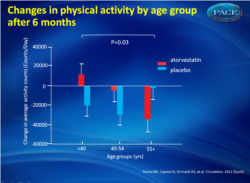STOMP: Atorvastatin does not reduce muscle strength
13/12/2012
Circulation. December 2012, The Effect of STatins On Muscle Performance study (STOMP) determined the incidence of statin-associated muscle complaints and examined the effect of statins on muscle performance and exercise capacity.
AbstractLiterature - Parker BA, Capizzi JA, Grimaldi AS, et al. Circulation 2012
The Effect of Statins on Skeletal Muscle Function.
Parker BA, Capizzi JA, Grimaldi AS, et al.Circulation. 2012 [Epub]
Background
Statins are very effective for reducing LDL-C, thereby reducing cardiovascular events markedly [1]. Statin use is often associated with mild muscle complaints or muscle weakness [2-4]. The effect of the drugs on muscle function has not been carefully observed in clinical trials. The Effect of STatins On Muscle Performance study (STOMP) determined the incidence of statin-associated muscle complaints and examined the effect of statins on muscle performance and exercise capacity.STOMP randomized 468 subjects to 80 mg daily atorvastatin or placebo. The subjects underwent exercise testing (including a questionnaire; handgrip, elbow-flexor, and knee-extensor strength testing; and a knee-extensor endurance exercise) after six months or after they reported muscle symptoms of statin-induced myalgia.
Main results
- The patients on atorvastatin showed a significant 20.8± 141.1U/L (p<0.0001) increase in creatine kinase, a biomarker of muscle damage, and 40 atorvastatin patients vs 29 placebo patients demonstrated creatine-kinase levels over the upper normal limit.
- New, otherwise-unexplained muscle pains were reported by 23 of the atorvastatin patients vs 14 placebo patients, while 19 atorvastatin vs 10 placebo patients' pain was persistent enough to be classified as myalgia (p=0.05).
- Myalgic subjects on atorvastatin reported mostly leg symptoms, while the myalgia seen in the placebo patient was more diverse. Myalgia tended to show up sooner in the atorvastatin patients than the control patients.
- The atorvastatin patients and control patients showed no differences in muscle strength, endurance, aerobic performance, or physical-activity levels. Physical activity decreased regardless of drug treatment, but the decrease in the atorvastatin group was driven by a drop in activity among the oldest tertile of study subjects (fig. 1)
Conclusion
Treatment for 6 months with high-dose atorvastatin does not decrease average muscle strength or exercise. The increase in creatine kinase suggests that high-dose atorvastatin produces mild muscle injury in even asymptomatic patients, an explanation for the often reported muscle complaints. These results should be confirmed in additional studies examining muscular performance with long term statin treatment in both healthy patients as well as those with confirmed statin-associated myalgia.References
- Lloyd-Jones D, Adams RJ, Brown TM, et al. Heart disease and stroke statistics--2010 update: A report from the american heart association. Circulation. 2010;121:e46-e215.
- Stecker EC, Vickers C, Waltz J, et al. Population-based analysis of sudden cardiac death with and without left ventricular systolic dysfunction: Two-year findings from the oregon sudden unexpected death study. J Am Coll Cardiol. 2006;47:1161-1166.
- Kannel WB, Wilson PW, D'Agostino RB, Cobb J. Sudden coronary death in women. Am Heart J. 1998;136:205-212.
- de Vreede-Swagemakers JJ, Gorgels AP, et al. Risk indicators for out-of-hospital cardiac arrest in patients with coronary artery disease. J Clin Epidemiol. 1999;52:601-607.
Many clinicians believe that statins cause muscle pain, but this has not been observed in clinical trials and the effect of statins on muscle performance has not been carefully studied.
Methods and results:
The Effect of STatins On Skeletal Muscle Function and Performance (STOMP) study assessed symptoms and measured creatine kinase (CK), exercise capacity, and muscle strength before and after atorvastatin 80 mg or placebo were administered for 6 months to 420 healthy, statin-naive subjects. No individual CK value exceeded 10 times normal, but average CK increased 20.8 ± 141.1 U/L (p<0.0001) with atorvastatin. There were no significant changes in several measures of muscle strength or exercise capacity with atorvastatin, but more atorvastatin than placebo subjects developed myalgia (19 vs 10; p = 0.05). Myalgic subjects on atorvastatin or placebo decreased muscle strength in 5 of 14 and 4 of 14 variables respectively (p = 0.69).
Conclusions:
These results indicate that high-dose atorvastatin for 6 months does not decrease average muscle strength or exercise performance in healthy, previously untreated subjects. Nevertheless, this blinded, controlled trial confirms the undocumented impression that statins increase muscle complaints. Atorvastatin also increased average CK suggesting that statins produce mild muscle injury even among asymptomatic subjects. This increase in CK should prompt studies examining the effects of more prolonged, high-dose statin treatment on muscular performance.

